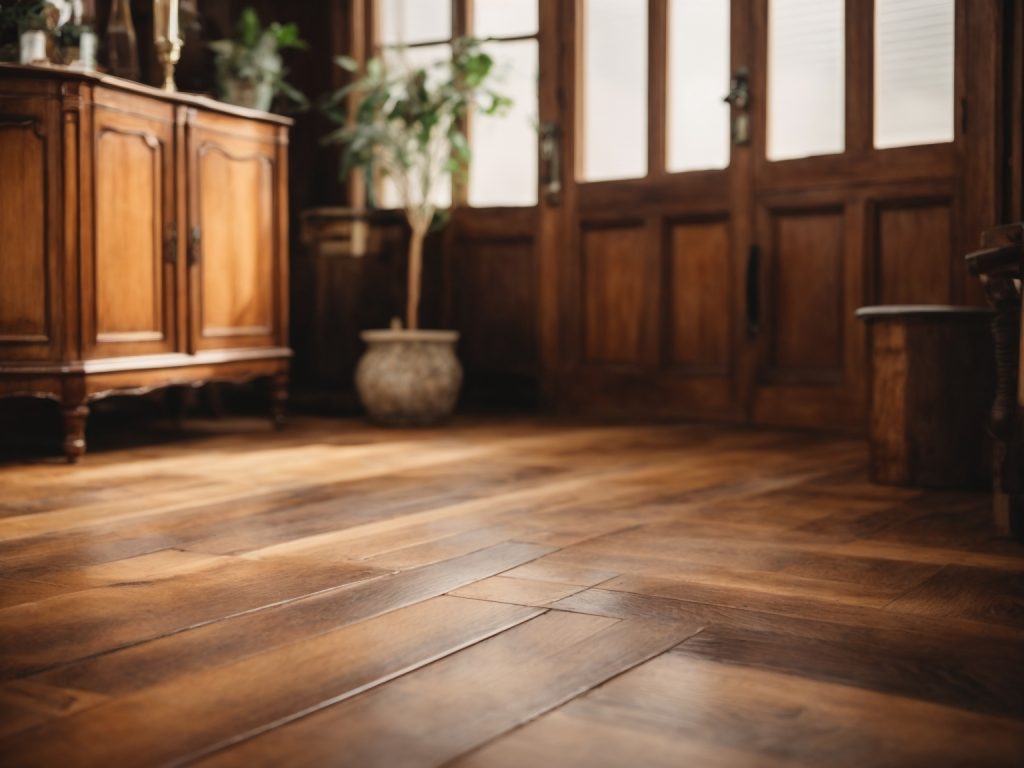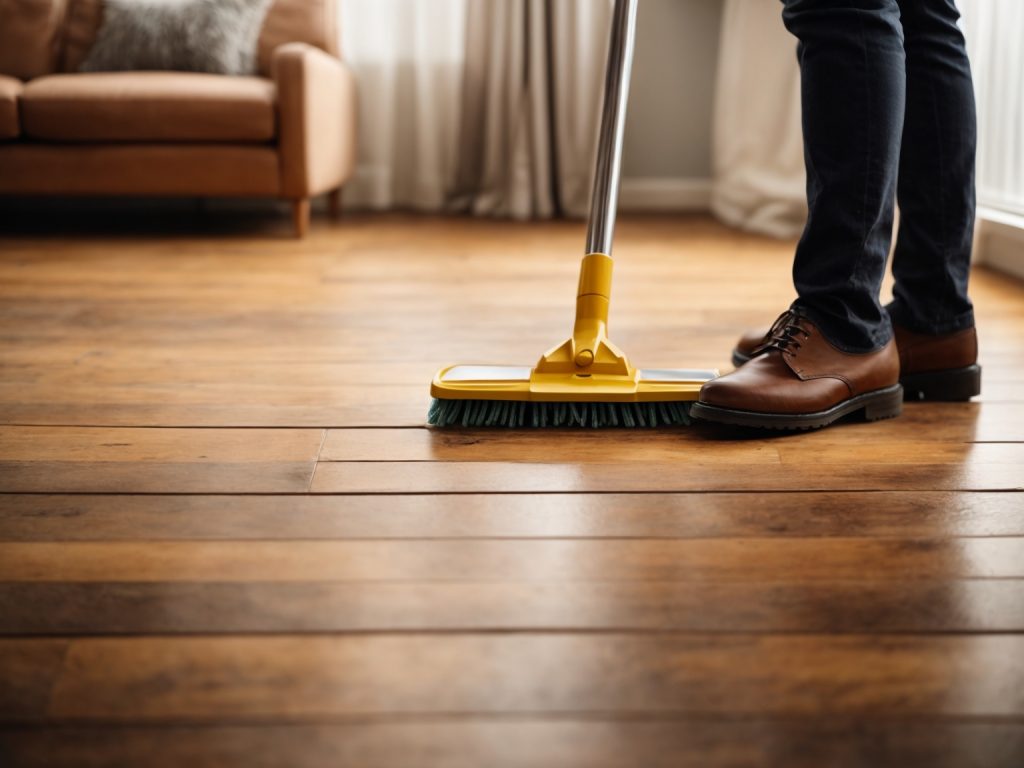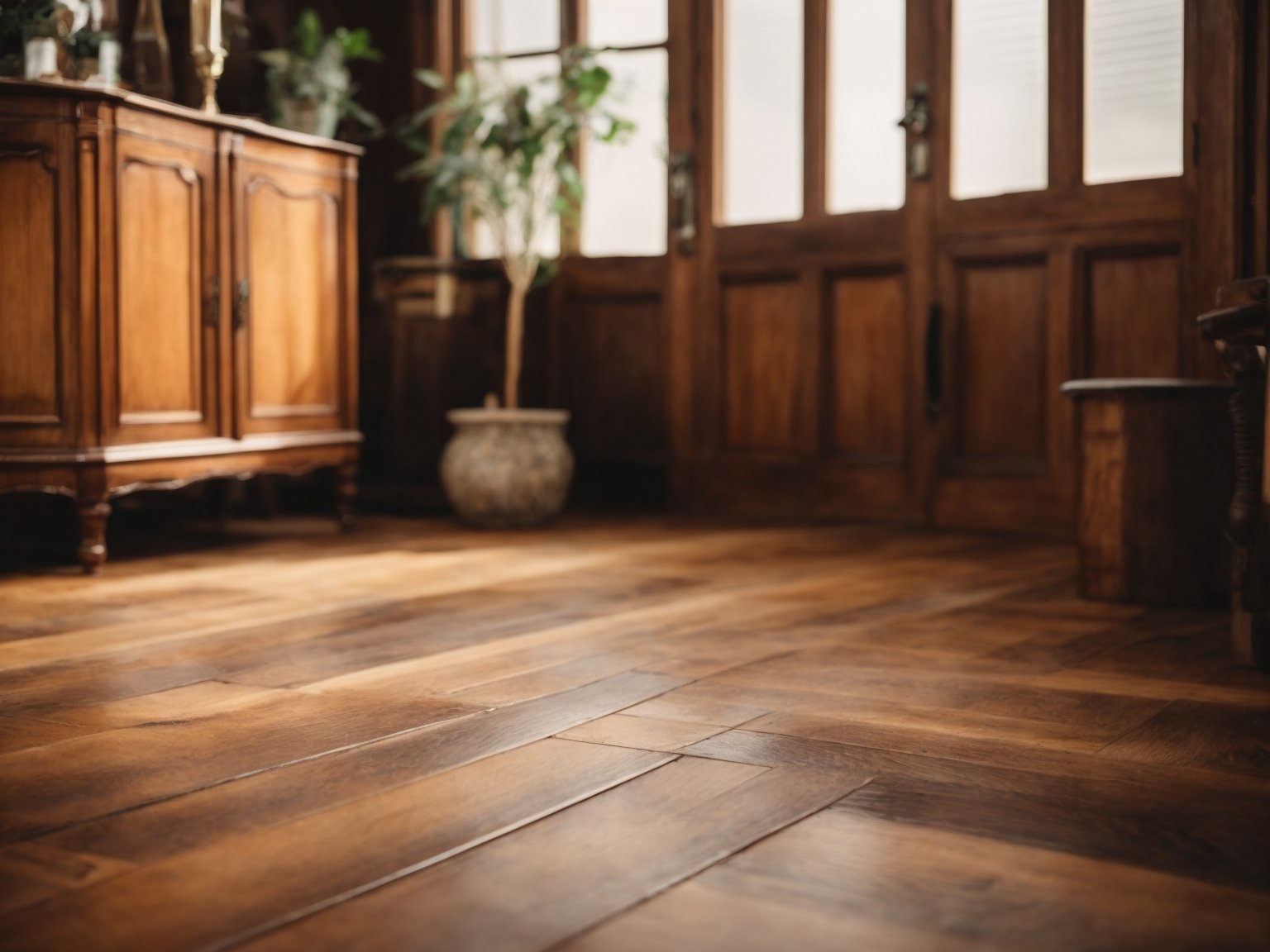Cleaning wooden floors can be a daunting task, but it doesn’t have to be. With the right tools and techniques, you can keep your wooden floors looking shiny and new for years to come. Here are some tips on how to clean a wooden floor effectively.
First, it’s important to determine the type of finish on your wooden floor. This will help you choose the right cleaning solution and avoid damaging the wood. If you’re unsure, try a small test area with a mild cleaning solution to see how the wood reacts. Once you know the type of finish, you can choose a cleaning solution that is safe and effective for your wooden floor.
Understanding Wood Floors
Wood floors add warmth and a unique look to your home decor. They are durable and can last for years if appropriately maintained. However, before you begin cleaning your wood floors, it’s essential to understand the type of wood and finish you have.
Types of Wood Floors
There are two types of wood floors: solid and engineered. Solid wood floors are made of one solid piece of wood and are available in various thicknesses. Engineered wood floors are made of several layers of wood and are more stable than solid wood floors.
Types of Wood Floor Finishes
There are three types of wood floor finishes: surface-sealed, penetrating-seal, and oil-treated. Surface-sealed finishes are the most common and have a protective layer on top of the wood. Penetrating-seal finishes soak into the wood and harden, providing a protective layer from the inside. Oil-treated finishes penetrate the wood and provide a natural look and feel.
How to Clean Wood Floors
Cleaning your wood floors is essential to maintain their shine and prevent damage. Here are some tips to clean your wood floors:
- Sweep or vacuum your wood floors regularly to remove dirt and debris.
- Use a damp mop with a mild cleaning solution to clean your wood floors. Avoid using excess water as it can damage the wood.
- Wipe up spills immediately to prevent damage to your wood floors.
- Use furniture pads to protect your wood floors from scratches and dents.
- Avoid using harsh chemicals, vinegar, or steam cleaners as they can damage the finish of your wood floors.
By understanding the type of wood and finish you have and following these cleaning tips, you can keep your wood floors looking beautiful for years to come.
Preparatory Steps Before Cleaning

Before you start cleaning your wooden floor, there are some preparatory steps you should take to ensure the best possible results. Here are some things you should do:
Remove Furniture and Rugs
First, remove any furniture and rugs from the room. This will give you more space to work and prevent any damage to your belongings. If you can’t move some furniture, use furniture pads or sliders to protect the legs and prevent scratches.
Sweep or Vacuum the Floor
Next, sweep or vacuum the floor to remove any loose dirt, dust, or debris. Use a soft-bristled broom or a vacuum cleaner with a hardwood floor attachment to avoid scratching the surface. If your vacuum has a beater bar, turn it off or adjust the height to the lowest setting.
Identify the Type of Wood and Finish
Before you start cleaning, identify the type of wood and finish of your floor. This will help you choose the right cleaning method and products that won’t damage the surface. Solid hardwood, engineered hardwood, and laminate wood-look flooring require different care, so make sure you know what you have.
Test the Cleaning Solution
Before you apply any cleaning solution to the entire floor, test it on a small, inconspicuous area first. This will help you make sure the solution doesn’t discolor or damage the wood. If you notice any adverse effects, try a different cleaning solution or consult a professional.
By following these preparatory steps, you’ll be able to clean your wooden floor more effectively and safely.
Choosing the Right Cleaning Supplies
Cleaning a wooden floor requires the right cleaning supplies to avoid damage to the wood. Here are some things to consider when choosing the right cleaning supplies for your wooden floor:
Type of Wood
Different types of wood require different cleaning supplies. For example, hardwood floors need a cleaner that is gentle and pH-neutral, while laminate floors require a cleaner that is specifically designed for laminate. Be sure to check the manufacturer’s recommendations to ensure you’re using the right cleaner for your wooden floor.
Cleaning Solution
When choosing a cleaning solution, avoid using harsh chemicals that can damage the wood. Instead, opt for a cleaner that is specifically formulated for wooden floors. You can also make your own cleaning solution by mixing water and vinegar or water and dish soap.
Cleaning Tools
The right cleaning tools can make all the difference when it comes to cleaning your wooden floor. A microfiber mop or cloth is gentle on the wood and won’t scratch the surface. Avoid using abrasive scrub brushes or steel wool, which can damage the wood.
Other Considerations
Here are a few other things to consider when choosing the right cleaning supplies for your wooden floor:
- Avoid using too much water, as excess moisture can damage the wood.
- Test any new cleaning supplies on a small, inconspicuous area of the floor before using them on the entire surface.
- Regularly sweep or vacuum your wooden floor to remove dirt and debris that can scratch the surface.
By choosing the right cleaning supplies, you can keep your wooden floor looking clean and beautiful for years to come.
Cleaning Process
Cleaning your wooden floors regularly is essential to maintain their shine and keep them looking new. Here are the steps you can follow to clean your wooden floors effectively:
- Start by removing any loose dirt or debris from the floor using a soft-bristled broom or a vacuum cleaner. Make sure to use a vacuum cleaner with a hardwood floor attachment to avoid scratching the surface of the floor.
- Once you have removed the loose dirt, it’s time to mop the floor. You can use a microfiber mop or a soft cloth to clean the floor. Avoid using a wet mop as excess water can damage the floor. Instead, dampen the mop or cloth with a hardwood floor cleaner and wring out any excess water.
- Begin mopping the floor from one end of the room to the other, working in small sections. Make sure to overlap each section to avoid missing any spots.
- If you come across any stubborn stains or spills, use a hardwood floor cleaner and a soft cloth to gently scrub the area. Avoid using harsh chemicals or abrasive cleaners as they can damage the floor.
- Once you have finished mopping the floor, use a dry microfiber mop or cloth to remove any excess water or cleaner. Make sure to dry the floor thoroughly to avoid any water damage.
- Finally, if you want to give your wooden floors an extra shine, you can use a hardwood floor polish. Apply the polish using a soft cloth or mop, following the manufacturer’s instructions.
By following these simple steps, you can keep your wooden floors looking clean and shiny for years to come.
The Do’s and Don’ts of Cleaning Wooden Floors
Cleaning wooden floors is not rocket science, but there are some things you should and shouldn’t do to keep them looking their best. Here are some do’s and don’ts to keep in mind:
Do’s
- Sweep or vacuum regularly: Dirt and dust can scratch and dull wooden floors, so it’s important to keep them clean. Use a soft-bristled broom or a vacuum cleaner with a hardwood floor attachment to remove dirt and debris.
- Clean up spills promptly: Water and other liquids can damage wooden floors, so it’s important to clean up spills as soon as possible. Use a soft, absorbent cloth to blot up the liquid, then clean the area with a damp cloth and dry it thoroughly.
- Use a gentle cleaner: When it’s time to give your wooden floors a deeper clean, use a cleaner that’s specifically designed for hardwood floors. Avoid using harsh chemicals or abrasive cleaners, which can damage the finish.
- Protect your floors: Use furniture pads under the legs of chairs, tables, and other furniture to prevent scratches and dents. Place doormats at entryways to trap dirt and debris before it gets onto your floors.
Don’ts
- Don’t use too much water: Wooden floors and water don’t mix well, so avoid using too much water when you’re cleaning them. Use a damp cloth, not a soaking wet one, and dry the floor thoroughly after cleaning.
- Don’t use steam cleaners: Steam cleaners can damage wooden floors by forcing moisture into the wood. Stick to using a gentle cleaner and a damp cloth.
- Don’t use abrasive cleaners: Avoid using harsh chemicals or abrasive cleaners, which can scratch and damage the finish of your wooden floors.
- Don’t use wax or oil-based cleaners: Wax and oil-based cleaners can leave a residue on your wooden floors, making them slippery and dull-looking.
By following these do’s and don’ts, you can keep your wooden floors looking their best for years to come.
Maintaining Your Wooden Floor

To keep your wooden floor looking great for years to come, it’s important to maintain it properly. Here are a few tips to help you maintain your wooden floor:
Sweep or Vacuum Regularly
One of the most important things you can do to maintain your wooden floor is to sweep or vacuum it regularly. Dirt, dust, and debris can scratch the surface of your floor, so it’s important to keep them off as much as possible. Use a soft-bristled broom or a vacuum with a hardwood floor attachment to sweep your floor daily.
Clean Up Spills Immediately
If you spill something on your wooden floor, be sure to clean it up immediately. Liquids can seep into the wood and cause damage if left to sit for too long. Use a soft cloth or paper towel to soak up the spill, then clean the area with a hardwood floor cleaner.
Use a Hardwood Floor Cleaner
When it’s time to clean your wooden floor, use a hardwood floor cleaner that is specifically designed for your type of flooring. Avoid using harsh chemicals or abrasive cleaners that can damage the finish of your floor. Follow the manufacturer’s instructions for best results.
Use Mats and Rugs
To help protect your wooden floor from scratches and wear, use mats and rugs in high-traffic areas, such as entryways and hallways. Be sure to use mats with a non-slip backing to prevent them from sliding around on your floor.
Avoid Excess Moisture
Excess moisture can cause your wooden floor to warp and buckle. Avoid using steam cleaners or wet mops on your floor, and be sure to clean up spills immediately. If you live in a humid environment, consider using a dehumidifier to help control moisture levels in your home.
By following these simple tips, you can help keep your wooden floor looking great for years to come.
Addressing Stains and Spills
Even with the best preventative measures, spills and stains are bound to happen on your wooden floors. Here are some tips on how to address them:
White Water Stains
White water stains are the result of moisture penetrating the finish and reaching the wood. To remove them, try one of the following methods:
- Apply a small amount of non-gel toothpaste to the stain and gently rub it with a soft cloth.
- Mix equal parts of baking soda and white toothpaste to create a paste. Apply it to the stain, let it sit for a few minutes, then wipe it away with a damp cloth.
Dark Stains
Dark stains are more difficult to remove and may require sanding and refinishing. However, before taking that drastic step, try the following:
- Mix equal parts of vinegar and olive oil. Apply the mixture to the stain and let it sit for several hours. Wipe it away with a clean cloth.
- If the stain is still present, mix equal parts of bleach and water. Apply it to the stain and let it sit for several hours. Rinse thoroughly with water and dry the area.
Spills
Spills should be addressed immediately to prevent them from seeping into the wood. Here’s what to do:
- For liquid spills, use a clean cloth or paper towel to blot up as much of the liquid as possible. Do not rub the spill, as this will push it deeper into the wood.
- For solid spills, use a plastic scraper or spatula to gently remove the spill. Be careful not to scratch the wood.
- Once the spill has been removed, clean the area with a damp cloth and dry it thoroughly.
By following these tips, you can keep your wooden floors looking their best, even when spills and stains occur.
Professional Cleaning and When to Consider It
While cleaning your hardwood floors at home can be a simple task, sometimes it may be necessary to seek professional help. Here are some situations where you may want to consider hiring a professional:
Deep Stains
If your hardwood floors have deep stains that you cannot remove with regular cleaning methods, it may be time to call in a professional. They have access to specialized equipment and cleaning solutions that can effectively remove stubborn stains without damaging your floors.
Extensive Damage
If your hardwood floors have extensive damage such as deep scratches, gouges, or warping, it may be time to consider professional refinishing. Refinishing can restore your floors to their former glory and make them look brand new again.
Time Constraints
If you lead a busy life and don’t have the time to devote to cleaning your hardwood floors, consider hiring a professional cleaning service. They can take care of your floors while you focus on other important tasks.
Inexperience
If you are unsure about how to properly clean and maintain your hardwood floors, it may be best to leave it to the professionals. They have the knowledge and experience to properly care for your floors and can provide you with tips and advice on how to keep them looking their best.
Overall, professional cleaning can be a great option for those who want to ensure their hardwood floors are properly cared for. Just be sure to do your research and choose a reputable and experienced professional to ensure the best results.
